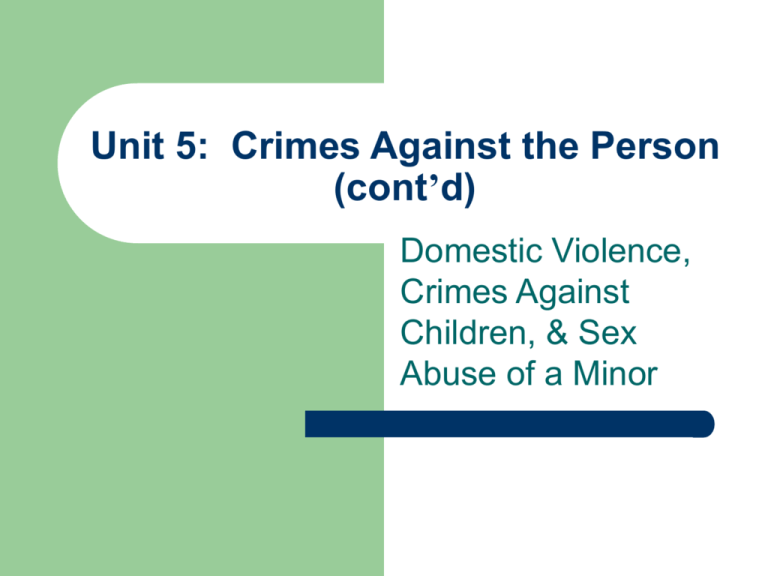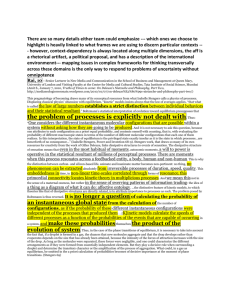
Unit 5: Crimes Against the Person
(cont’d)
Domestic Violence,
Crimes Against
Children, & Sex
Abuse of a Minor
Domestic Violence/Crime Against Child
Deportability Ground
Deportable, not inadmissible
–
INA 237(a)(2)(E), 8 USC 1227(a)(2)(E)
Conviction of “crime of domestic violence,”
“crime of stalking”, or “crime of child
abuse…neglect…or abandonment” or
Court finding of violation domestic violence
protection order
Domestic Violence/Crime Against Child
Deportability Ground (2)
Conviction or protection order violation
must occur after 9/30/96, and after
admission
No particular sentence required
(unlike COV AF)
Crime of Domestic Violence (CODV)
Two-pronged analysis:
1. COV as defined in 18 USC § 16; and
2. Against a person covered under a
defined domestic relationship.
(So, property crimes can’t be CODV)
CODV - Covered Relationships
•
•
•
•
Current or former spouse
Co-parent of child
Current or former cohabitor as a spouse
Person “similarly situated” to spouse under law
of the jurisdiction of offense
• Other person protected under domestic or
family violence laws
! Watch out for state/local law that protects broader
class of persons, e.g. dating without cohabiting,
blood relative, etc.
CODV - Strategies
Three Safe Havens:
(1) Avoid a COV as defined in 18 USC § 16
(2) Avoid a crime against the person
(3) Avoid a protected person (someone
who falls under the covered relationship)
CODV Strategies –
Avoiding Covered Relationship:
• Plead to offense against person who does not
fall within covered relationships
• If such person is covered, do not identify
relationship in record of conviction ! But circuits split on whether immigration court
may look outside ROC to determine whether
offense was against person in covered
relationship (e.g. 9th, 7th, 2nd).
Compare circuit case law
• 9th Circuit – held IJ erred in relying on
testimony outside record of conviction to prove
covered domestic relationship. Tokatly v.
Ashcroft, 371 F.3d 613 (9th Cir. 2004).
• 7th Circuit – suggested domestic relationship
may be proved, without reference to elements
of the state crime, by substantial evidence
(presumably not limited to record of
conviction). Flores v. Ashcroft, 350 F.3d 666
(7th Cir. 2003), citing Sutherland v. Reno, 228
F.3d 171 (2d Cir. 2000).
CODV Strategies
Work with prosecutor and/or complaining
witness - Many CWs have strong interest
in defendant not being deported
Pre-plea, pre-admission diversion
Expungement – no
Vacation of judgment for cause – yes
Contrast COV Aggravated Felony
and CODV Deportation Grounds
Both COV AF and CODV deportation grounds require
18 USC 16 “crime of violence.”
For COV AF, need one-year sentence imposed.
For CODV, need covered relationship; sentence
irrelevant.
CODV is deportation ground only and does not bar
most relief; AF has more serious consequences.
Crime of stalking or of child abuse,
neglect or abandonment
Unlike CODV, these grounds do not require
that the offense have been committed against
a specified protected person.
If CW is child, try to plead to an offense without
the element of age.
Crime of stalking or of child abuse,
neglect or abandonment
These terms are not defined in INA.
There are almost no published cases
defining these terms for purposes of
deportation ground.
Child Abuse - Interpretations (1)
The BIA has noted that by its common usage,
‘child abuse’ encompasses actions or
inactions that do not require physical contact.
The BIA has also noted Black’s definition of
child abuse: any form of cruelty to a child’s
physical, moral, or mental well-being.
In re Rodriguez-Rodriguez, 22 I. & N. Dec. 991
(BIA 1999); In re Manzano-Hernandez, 2005
WL 698392 (BIA 2005) (unpublished).
Child Abuse – Interpretations (2)
Eighth Circuit cited definitions of child abuse in
Rodriguez-Rodriguez and Manzano-Hernandez to
uphold finding that offense fell within the child abuse
ground of deportability. Loeza-Dominguez v. Gonzales,
428 F.3d 1156 (8th Cir. 2005).
Statute, entitled “malicious punishment of a child,”
punished “A parent, legal guardian, or caretaker who,
by an intentional act or a series of intentional acts with
respect to a child, evidences unreasonable force or
cruel discipline that is excessive under the
circumstance.” Minn. Stat. § 609.377(1).
Sex Abuse of a Minor (SAM)
Aggravated Felony
AF categories include “sexual abuse of a
minor”. 8 USC 1101(a)(43)(A), INA
101(a)(43)(A)
No sentence imposed requirement.
Can be a misdemeanor! Matter of Small, 23 I&N
Dec. 448 (BIA 2002); Guerrero-Perez v. INS, 242 F.3d
727 (7th Cir. 2001); Marin-Navarette, 244 F.3d 1284
(11th Cir. 2001).
SAM - BIA Standard
Matter of Rodriguez-Rodriguez, 22 I&N
Dec. 991 (BIA 1999)
–
Found TX statute for indecent
exposure to person under 17 is SAM
–
Focused on “high degree of mental
culpability” required under the TX
statute (knowledge & intent to arouse)
SAM - BIA Approach
Rejected adoption of basic federal sexual
abuse statute as the standard in favor of
18 USC 3509 (re: rights of child
witnesses).
18 USC 3509
Defines‘sexual abuse’ as:
“The employment, use, persuasion,
inducement, enticement, or coercion of
a child to engage in, or assist another
person to engage in, sexually explicit
conduct or the rape, molestation,
prostitution, or other form of sexual
exploitation of children, or incest with
children.”
SAM – Compare Circuit case law
“Neither the agency’s reliance on 18
U.S.C. § 3509(a) . . . to determine the
meaning of ‘sexual abuse of a minor,’
nor the resulting definition, is
unreasonable.” Mugalli v. Ashcroft, 258
F.3d 52 (2d Cir. 2001).
SAM – 3d Circuit
“[W]e have no quarrel with this approach . . . .”
Singh v. Ashcroft, 383 F.3d 144, 153 (3d Cir.
2004) (dicta).
SAM - 7th Circuit
“We find the BIA’s definition of
sexual abuse of a minor to be a
reasonable construction.” Lara-Ruiz
v. INS, 241 F.3d 934 (7th Cir. 2001)
SAM – 10th Circuit
Vargas v. DHS, ___ F.3d ___, No. 05-9581,
2006 WL 1689293, *4 (10th Cir. June 21, 2006)
(basing decision, without comment, on
definition of “sexual abuse of a minor” at §
3509(a)).
SAM – 9th Circuit
US v. Baron-Medina, 187 F.3d 1144 (9th
Cir 1999)
– Uses “ordinary, contemporary and
common meaning” (not federal statute)
– Held conviction under Cal. Penal Code
§ 288(a) is AF despite fact can include
“innocent” appearing contact or no
contact (causing child to touch self) w/
lewd intent
SAM – 9th Circuit (2)
Baron-Medina continued
“The use of young children for the
gratification of sexual desires constitutes
an abuse”
Note that age of victim was 14 and
under
SAM – 9th Circuit (3)
U.S. v. Pallares-Galan, 359 F.3d
1088 (9th Cir. 2003) (illegal reentry
case)
–
Misdemeanor conviction for “annoying or
molesting a child under 18” is not
necessarily an aggravated felony because
the statute includes conduct that does not
constitute sexual abuse under ordinary
meaning of the phrase
SAM - 9th Circuit (4)
Pallares-Galan continued
Court focused on fact that statute includes
conduct that merely “annoys” or “irritates”
(making gestures from car, public urination)
“[T]he California misdemeanor statute is
intended to outlaw. . .‘objectively annoying
conduct.’ Such conduct may involve neither
harm or injury to a minor, nor the touching of
or by a minor, and does not constitute
‘sexual abuse of a minor’”
SAM - Scope of Record
Will court look beyond record to determine age?
– Compare Singh v. Ashcroft, 383 F.3d 144 (3d Cir.
2004) (refusing to look at sentencing order, which
indicated victim’s name where statute silent as to
age) with Espinoza-Franco v. Ashcroft, 394 F.3d
461, 465 (7th Cir. 2005) (“[W]e have approved
looking beyond the indictment to determine the
victim's age so long as doing so would not require
an evidentiary hearing.”); Lara-Ruiz v. INS, 241 F.3d
934 (7th Cir. 2001) (affirming BIA even though
source of age information unclear).
Specific SAM and Rape Offenses
Sexual Abuse of a Minor
“Lewd and Lascivious Acts Involving
Children” Cal. Penal Code § 288(a); BaronMedina; see also US v. Efigenio, No. 052617 (3d Cir. May 24, 2006) (unpublished)
“Penetration by Foreign Object” Cal.
Penal Code § 289(j); US v. Mendoza-Iribe,
198 F.3d 742 (9th Cir. 1999)
Sample SAM and Rape Offenses 2
“Lewdness with a Child Under 14 Years” Nev. Rev.
Stat. § 201.230 (1996); Cedano v. Ashcroft, 324 F.3d
1062 (9th Cir. 2003)
“Indecency with a Child by Exposure”, Tex. Penal
Code §21.11(a)(2); Matter of Rodriguez-Rodriguez
“Sexual Abuse in the Second Degree”, N.Y. Penal
Law § 130.60(2); Matter of Small
Specific SAM and Rape Offenses 3
“Indecent assault and battery on a child
under 14” Mass. Gen Laws ch 265 § 13B;
Emile v. INS, 244 F.3d 183 (1st Cir. 2001)
“Contact with intimate parts of a child
under 16” Conn. Gen. Statute § 53-21(a)(2).
Santos v. Gonzales, 426 F.3d 323 (2d Cir.
2005) (per curiam).
“Second degree sexual abuse” Ken.R.S. §
510.120; U.S. v. Gonzales-Vela, 276 F.3d
763 (6th Cir. 2001)
Specific SAM and Rape Offenses 4
“Taking Indecent Liberties With a Child”
N.C. Gen. Stat. § 14-202.1(a)(1), Bahar v.
Ashcroft, 264 F.3d 1309 (11th Cir. 2001)
(requiring no phys. contact)
“Lewd and Lascivious Assault on a Child”
Fla. Stat. Ann. § 800.04; Londono Quintero,
289 F.3d 147 (1st Cir. 2002); U.S. v. PadillaReyes, 247 F.3d 1158 (11th Cir. 2001)
“Solicitation of a sexual act” ILCS 5/1114.1(a); Gattem v. Gonzalez, 412 F.3d 758 (7th
Cir. 2005) (not partic. to minors)
Specific SAM and Rape Offenses 5
! Beware cross-referenced or implicit offenses
“Contributing to the delinquency of a minor” Colo.
Rev. Stat. § 18-6-701 penalizes “induc[ing] . . . or
encourag[ing] a child to violate any state or federal law,
municipal or county ordinance, or court order.”
10th Cir. found this to be SAM where complaint
specified that encouraged child to violate § 18-3404(1)(a), “unlawful sexual contact,” a statute not
particular to minors. Vargas v. DHS, ___ F.3d ___, No.
05-9581, 2006 WL 1689293, *4 (10th Cir. June 21,
2006).
SAM - Grey Areas
“Statutory Rape” (e.g., Cal. Penal Code § 261.5,
NY Penal Law § 130.25-2); Mugalli v. Ashcroft, 258
F.3d 52 (2d Cir. 2001); Toledo-Castillo v. Ashcroft,
2001 U.S. App. LEXIS 7296 (9th Cir. 2001)
(unpublished); United States v. Salas-Rivera, 2001
U.S. App. LEXIS 18931 (9th Cir. 2001)
(unpublished)
– Argue not “abuse” under ordinary meaning of
term because (1) No specific scienter
requirement; (2) small age differential between
victim and perpetrator; (3) marriage exception
SAM – Grey Areas 2
“Statutory rape” may nonetheless be “rape”
AF under 101(a)(43)(A):
–
Rivas-Gomez v. Gonzalez, 441 F.3d 1072 (9th Cir.
2006) (discussing ORS § 163.355):
Common contemporary meaning of “rape” is unlawful
sexual activity without consent
–
Minority of c/w makes statutory rape unlawful
– Conclusive statutory presumption of inability to consent
Distinguishes Pallardes-Gallan b/c felony rape, “whatever
the methodology of the offender[,] appears to us to fall
above the line”
Possible SAM Solutions
Crime that doesn’t have age as an element
(won’t work in 7th Circuit)
– Make sure record of conviction is clean and
doesn’t include facts that satisfy the generic
definition
Simple assault/battery
Misdemeanor annoying or molesting child
under 18: e.g. Cal Penal Code 647.6 (per
Pallardes-Gallan)
Possible SAM Solutions 2
Sexual battery
– Record of conviction can’t supply element of
age or sex intent where not in statute
– Must have sentence < 1year to avoid
COV/obstruction of justice AF
False Imprisonment
– Must have sentence < 1year to avoid COV
AF





